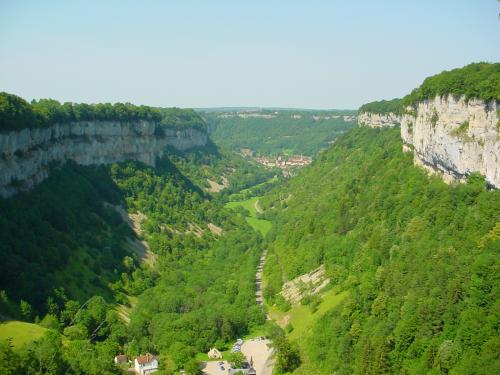steephead valley on:
[Wikipedia]
[Google]
[Amazon]
 A steephead valley, steephead or blind valley is a deep, narrow, flat bottomed
A steephead valley, steephead or blind valley is a deep, narrow, flat bottomed
 A steephead valley, steephead or blind valley is a deep, narrow, flat bottomed
A steephead valley, steephead or blind valley is a deep, narrow, flat bottomed valley
A valley is an elongated low area often running between hills or mountains and typically containing a river or stream running from one end to the other. Most valleys are formed by erosion of the land surface by rivers or streams over ...
with an abrupt ending. Such closed valleys may arise in limestone
Limestone is a type of carbonate rock, carbonate sedimentary rock which is the main source of the material Lime (material), lime. It is composed mostly of the minerals calcite and aragonite, which are different Polymorphism (materials science) ...
or karst
Karst () is a topography formed from the dissolution of soluble carbonate rocks such as limestone and Dolomite (rock), dolomite. It is characterized by features like poljes above and drainage systems with sinkholes and caves underground. Ther ...
landscapes, where a layer of permeable rock lies above an impermeable substrate such as marl
Marl is an earthy material rich in carbonate minerals, Clay minerals, clays, and silt. When Lithification, hardened into rock, this becomes marlstone. It is formed in marine or freshwater environments, often through the activities of algae.
M ...
. Water flowing through a steephead valley leaves via one or more ponor
A ponor is a natural opening where surface water enters into underground passages; they may be found in Karst topography, karst landscapes where the geology and the geomorphology is typically dominated by porous limestone rock. Ponors can drain s ...
s or sinkhole
A sinkhole is a depression or hole in the ground caused by some form of collapse of the surface layer. The term is sometimes used to refer to doline, enclosed depressions that are also known as shakeholes, and to openings where surface water ...
s.
Blind valleys are typically dry at their lower ends. If the ponor cannot contain the high runoff during a flood event an intermittent flow may continue through the valley beyond the sink. Such a landform is called a semi-blind or half-blind valley.
Development
They are created by a stream flowing within the permeable rock and eroding it from within, until the rock above collapses opening up a steep narrow valley which is then further eroded by the stream running across the impermeable valley floor. At the head of the valley the stream emerges from the rock as a spring. Notable examples can be found in the Jura region ofFrance
France, officially the French Republic, is a country located primarily in Western Europe. Overseas France, Its overseas regions and territories include French Guiana in South America, Saint Pierre and Miquelon in the Atlantic Ocean#North Atlan ...
, for example the Reculée de Baume at Baume-les-Messieurs and the Reculée d'Arbois with its head at Les Planches-près-Arbois and its exit at Arbois
Arbois () is a Commune in France, commune in the Jura (département), Jura Departments of France, department, in the Bourgogne-Franche-Comté Regions of France, region, eastern France. The river Cuisance passes through the town, which centres o ...
.
In North America
North America is a continent in the Northern Hemisphere, Northern and Western Hemisphere, Western hemispheres. North America is bordered to the north by the Arctic Ocean, to the east by the Atlantic Ocean, to the southeast by South Ameri ...
, blind valleys (the preferred American term) are found in the Driftless Area
The Driftless Area, also known as Bluff Country and the Paleozoic Plateau, is a topographic and cultural region in the Midwestern United States that comprises southwestern Wisconsin, southeastern Minnesota, northeastern Iowa, and the extreme ...
and other karst regions.
Examples
* Tasghîmût * Gara MedouarSee also
* Box canyonReferences
Canyons and gorges Geomorphology Valleys {{topography-stub